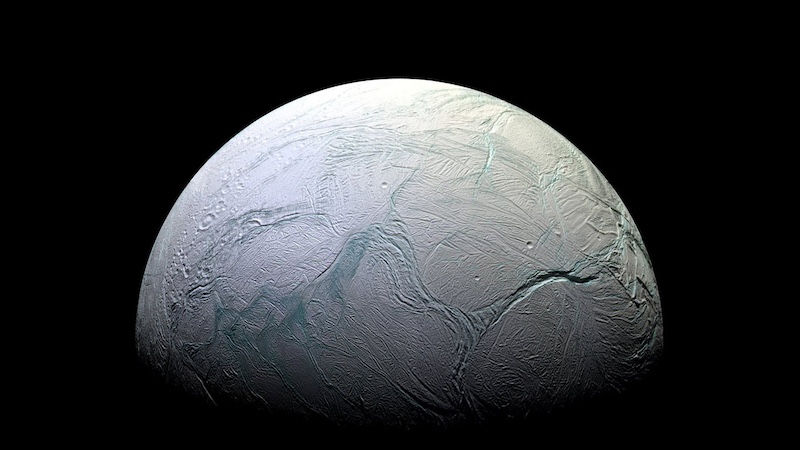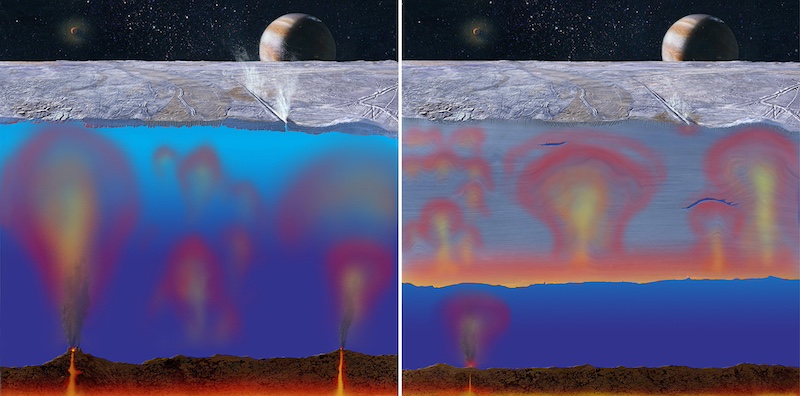
- Could life exist in the oceans that lie under the icy crusts of Jupiter’s moon Europa or Saturn’s moon Enceladus? The answer may largely depend on the water’s temperature.
- Researchers at Cornell University unveiled a new method to take the temperature of these ocean moons based on the thickness of their ice shells.
- The method involves ice pumping, a process that happens where the ice shell meets the hidden ocean, which influences the thickness and shape of the ice shell.
Measuring water temperature on ocean moons
Ocean moons – those with water oceans beneath their icy crusts – are common in our solar system. Saturn’s Enceladus and Jupiter’s Europa are the two most well-known of these exotic worlds. And ocean temperature is a big factor in determining if they’re habitable. On February 29, 2024, researchers at Cornell University in Ithaca, New York, said they’ve devised a new way of taking their temperatures. They said the thickness of the ice shell (crust) can reveal the temperature of the water below. Indeed, the technique has already provided new details about Enceladus’ ocean and can be applied to Europa and other moons as well.
The researchers published their peer-reviewed results in the Journal of Geophysical Research: Planets (an AGU journal) on February 13, 2024.
Antarctic ice shelves as an analog to ocean moons
The new method for measuring temperatures in ocean moons involves a process called ice pumping. This occurs below the ice shelves in Antarctica, and scientists said it likely happens on Europa and Enceladus, too. On these moons, it occurs at the bottom of the ice shells, where the ice and ocean water meet and interact.
How does ice pumping work? Essentially, the freezing point of water negatively depends on pressure: As depth and pressure increase in the ocean, water must be colder to expand and freeze. Deeper down, the pressure is greater and the freezing point is colder. This means that ocean currents can melt ice more easily. So, if the melted ice water is buoyant and rises to shallower depths and lower pressure, it will freeze again. The cycle redistributes some ice within an ice shelf or shell. Consequently, this changes its composition and texture.
Lead author Justin Lawrence, a visiting scholar at the Cornell Center for Astrophysics and Planetary Science (A&S), said:
Anywhere you have those dynamics, you would expect to have ice pumping. You can predict what’s going on at the ice-ocean interface based on the topography; where the ice is thick or thin and where it is freezing or melting.
Measuring the thickness of ice shells
The thickness variations in the ice shells can provide clues about how ice pumping is affecting the bottoms of the ice shells. Therefore, it also helps scientists determine the temperature of the water. So measuring the thickness of the ice shells is key to learning more about conditions in the oceans just below the ice. That includes the water temperature. And, of course, this relates to the issue of habitability. As co-author Britney Schmidt at the College of Arts and Sciences and Cornell Engineering noted:
If we can measure the thickness variation across these ice shells, then we’re able to get temperature constraints on the oceans, which there’s really no other way yet to do without drilling into them. This gives us another tool for trying to figure out how these oceans work. And the big question is, are things living there, or could they?
Similarities of ocean moons to Antarctica
In the new study, the researchers mapped possible ranges of potential shell thickness, pressure and salinity for ocean moons with varying gravity. The results suggested that ice pumping would occur in the most probable scenarios, but not in all of them. In particular, ice-ocean interactions on Europa may be similar to those beneath the Ross Ice Shelf, the largest ice shelf in Antarctica. In fact, the results show the conditions just beneath Europa’s ice shell may be quite Earth-like.
The varying thickness, and thus shape, of the ice shell has an effect on the ocean temperature. As Schmidt said:
There’s a connection between the shape of the ice shell and the temperature in the ocean. This is a new way to get more insight from ice shell measurements that we hope to be able to get for Europa and other worlds.

Enceladus’ ocean: Cold but habitable
Enceladus is the first ocean moon for which researchers have been able to calculate the ocean temperature. This is based on data from the previous Cassini mission. The result? The ocean, at least under the ice, is about -1.095 to -1.272 degrees Celsius (30 to 29.7 degrees Fahrenheit). By comparison, the temperature at the base of the Ross Ice Shelf is -2.16 Celsius (28.1 °F). Not warm, but it’s still home to a rich ecosystem.
Notably, Cassini found evidence of hydrothermal activity on Enceladus’ ocean floor. This is similar to hydrothermal vents in Earth’s oceans, which provide heat and nutrients for a wide range of organisms. And overall, the ocean is now thought to be even more potentially habitable than previously known.
On Europa, the scientists said that the ice pumping process is probably fairly strong, helping to smooth and flatten the base of the ice shell. But on much smaller Enceladus, however, it is likely weaker.
NASA’s upcoming Europa Clipper mission, with a launch target of October 10, 2024, will be able to more accurately determine the thickness of the moon’s ice shell. This will help scientists learn more about the potential habitability of its hidden ocean.
Bottom line: Researchers at Cornell University say that scientists can determine the water temperature of ocean moons by measuring the thickness of their ice shells. This data may provide insight into whether or not these oceans are suitable for life.
Source: Ice-Ocean Interactions on Ocean Worlds Influence Ice Shell Topography
Read more: Europa’s icy crust rides on warm ocean currents
Read more: Watery plumes on Enceladus could hold signs of life











